I first used a cabbage poultice some ten years ago on one of my serial broody hens, Lucky. She was always sitting with or without eggs and often with some results she probably didn't count on, see below! After one particularly long period of being broody in which she sat with, or rather partially wedged underneath, three other hens, I noticed she developed a limp. When she came off the nest she began to lift her one leg off the ground and hold it tightly in a ball, as if some involuntary nerve spasm was forcing this to happen.
As I could find nothing obviously wrong with her foot or leg, I asked the advice of a friend of mine, an organic dairy farmer, who as part of her continuing education had spent several months shadowing an organic vet. She suggested Lucky might have a constriction in her leg caused by a swelling on her 'knee' and it was true she did have what seemed the very slightest evidence of scaly leg mite in this area. My friend Marie-Agnès suggested that I tried a cabbage poultice, traditionally used here in France for many conditions including inflammation due to sprains, strains and cancers. I put a poultice on Lucky over the following five nights it was so successful I have always kept part of the ingredients 'on ice' and ready just in case.
Recently I had occasion to use this poultice again on two cases which turned up simultaneously, one of my quail, Drusilla injured her foot and my neighbour's hen had a case of suspected bumblefoot. As I already mentioned before, one of the ingredients I always have in stock in the freezer. This is organic pig's lard which I rendered down from trimmings given to me freely by our organic butcher. It might be an idea, if you have one near you to ask, as I do find this type of fat very suitable as a carrier for making any kind of poultice. I have, at a pinch also used coconut oil but it melts very quickly particularly on a hot foot, whereas the lard keeps its form for longer.
This poultice keeps very well in a cool place, so you can make enough for five treatments at a time. Just consider when preparing it that it is the cabbage that is the active ingredient so you need by volume more of it than the fat.
Brassicas - Anti-inflammatory and Anti-microbial Properties
Cabbage contains several anti-inflammatory nutrients, including:
- anthocyanins (flavenoids which make the red/blue pigment in fruit and vegetables) these are obviously more prevalent in red cabbage,
- polyphenols (antioxidants) present in abundance in all kinds of cabbage and
- the amino acid L-glutamine.
Cabbage also contains:
- the glucosinolate, sinigrin, which has anti-microbial properties. The Savoy cabbage I use is the one with a higher proportion of sinigrin, which is also prevalent in the seeds of another brassica, black mustard and was used historically in medicine as a 'mustard plaster'. Sinigrin is now being looked at in relation to cancer prevention and treatment, in particular colon, bladder and prostate cancers. Research published in 2014 also highlighted the potential of sinigrin as an anti-cancer agent for liver cancer.
Above - my neighbour's hen with swelling to the metatarsal pad of her foot.
Timing
The best time to put a poultice on poultry is at night, cabbage poultices, particularly when made with a delicious organic fat can be very interesting to a bird, even one who has just dined. I like to put the poultice on and then put the patient to bed in a cardboard box in the dark. In the morning I get the poultice off early so the patient doesn't have time to investigate, start to unravel and/or eat the poultice. A cabbage poultice has the ability to withdraw toxins, so it's best not to let the bird get a chance of eating it. However, with the very professional vet bandage (above) we did make an exception as there was no way my neighbour's hen could break into it!
Ingredients and Materials
Several large leaves of organic cabbage, I like to use Savoy but I have used red cabbage too.
A walnut-sized piece of pig's lard
Organic cotton wool (25% of the World's pesticides are used in the production of cotton)
A bandage, or in my case remnant strips of organic fabric or old organic tee shirts!
Method
Chop cabbage roughly and then dice using a stick blender or liquidiser.
Add fat and make it into a smooth green paste. You can obviously do this all by hand but you will need to chop the cabbage very finely to extract the maximum amount of juice to be carried by the fat.
Add fat and make it into a smooth green paste. You can obviously do this all by hand but you will need to chop the cabbage very finely to extract the maximum amount of juice to be carried by the fat.
Liberally spread over affected area, I like to make it about 1cm (½") thick.
Cover with cotton wool, paying particular attention, when treating a foot as in this case (right) to the area between the claws, this helps to keep the whole preparation together whilst getting ready for the final bandage.
My neighbour works for the local vet so she had some very professional-looking additional stretch wrappings!
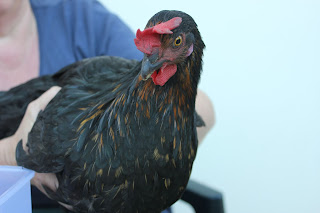 As I mentioned above, I put a fresh poultice on each night for five nights and this brought down the swelling on both Lucky and my quail. For my neighbour's hen, the swelling came down to reveal the tell-tale black 'scar' of bumblefoot, so we applied one drop of Tea Tree essential oil dissolved in one teaspoon of coconut oil evening and morning for five days, when the scar opened up and the hard pad of infection came out of its own accord. My neighbour then went on to disinfect the area further and bandage it up.
As I mentioned above, I put a fresh poultice on each night for five nights and this brought down the swelling on both Lucky and my quail. For my neighbour's hen, the swelling came down to reveal the tell-tale black 'scar' of bumblefoot, so we applied one drop of Tea Tree essential oil dissolved in one teaspoon of coconut oil evening and morning for five days, when the scar opened up and the hard pad of infection came out of its own accord. My neighbour then went on to disinfect the area further and bandage it up.I further complemented the treatment for my injured quail with nutritional support and the article in which I discuss this can be accessed below via the 'read more' live link.
If you have enjoyed this
piece and found it
useful think about sharing it with your family and friends, on social
media and also maybe about joining this blog
and/or subscribing to my Youtube channel or even supporting us on
Patreon or Please
also feel free to ask questions.
All the very best,
Sue
RELATED POSTS
Treating an injured quail Nutritional support for sprains, strains and nerve damage
Here's Drusilla she is one of my coturnix quail and over the past few
days she has started to limp, holding up her foot and hopping...read more
Treating a nasty head wound and shock
Our poor quail, Nuggets with a horrible injury to her head and eyes (Happy ending!) ...read more
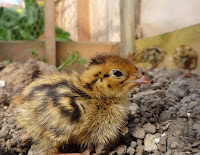 Identification of riboflavin deficiency in purchased quail and hatching eggs
Identification of riboflavin deficiency in purchased quail and hatching eggs
Quail have a high basal metabolic rate and as such their problems with nutrition are dramatically and rapidly revealed...read more
 Cure curled toe paralysis (riboflavin deficiency)
Cure curled toe paralysis (riboflavin deficiency)
For my 'field study', I am using the example of quail chicks, from
non-organic purchased hatching eggs because this is the area in which,
sadly I have a great deal of experience ..read more
RETURN TO CONTENTS PAGE
© Sue Cross 2016



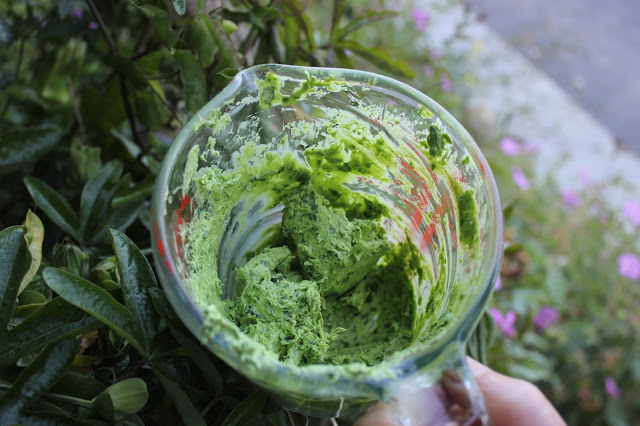

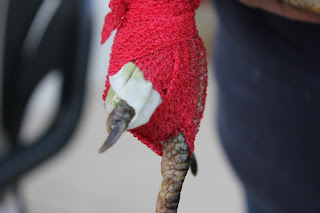


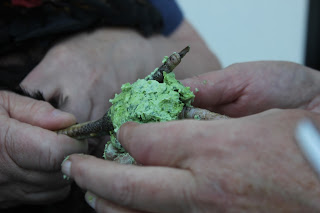





This was a great read and very informative. Loved it. Love what you do and share. I could watch your videos all day :)
ReplyDeleteHi Molly, aaww thanks so much for those great comments. You certainly made my day! I hope to get some more videos out very soon. All the very best from a rather chilly Normandie, Sue
DeleteHi Sue,thankyou for your post.just wondering best method to treat a 3 week old Japanese quail who has suddenly unable to walk,no support in the legs. at all but eats and drinks.I don't visually see an injury but I think the quails must have sat on it.Would Brassicas help along with
ReplyDeleteanything else?cheers
Hi Tina, Thanks for you question! With quail because of their high basal metabolism, if the bird has suddenly lost the ability to walk with no visible sign of injury I always think firstly about food intake and nutrient deficiencies. Three weeks is around the period some of these deficiencies can kick in, as the quail are getting up to speed and are thus using up any reserves. So, are these your own chicks or did you buy hatching eggs or chicks? Secondly what are you feeding them? Thirdly what are they actually eating, individually? Quail are like chickens, they are very knowledgeable as to their optimum diet, so if there is not enough of a certain important dietary element available, a specific quail could be pushed and/or left out and thus deficient. Fourthly, have you watched how your quail behave as a group, is this particular quail under stress in any way? Stress directly causes flushing and leaching of certain nutrients, as well as the depletion of many others and/or inhibiting the uptake of specific vital compounds such as Vitamin B12, which is responsible for both motor and nervous system function.
DeleteEven if none of the above apply and thus you believe the bird is injured I would still start with nutrition. I would re-investigate both legs and make sure there are no tell take bruise marks, they do take some time to emerge. I accidentally trod on one of my quail chicks feet last year and it took some time to even show. I did the cabbage poultice on it and also one with green clay.
So if you bought the quail and unless they are from an organic or naturally raised, or well-known source then I would be thinking of upping all the B complex vitamins and amino acids. The most crucial Bs for quail seem to be: thiamine, riboflavin, niacin, folate and cobalamin (B1, B2, B3, B9, B12) but you will get all of the B complex and crucial amino acids such as l-methionine from invertebrate protein except folate which you can get in green leafy vegetables. I would also be thinking about vitamin D3, if you are living in an area 37 degrees south of the Earth's equatorial plane then your quail will still be able to synthesize vitamin D from direct sunlight, otherwise a little raw organic butter or cream from grass-fed cows milk. Goat milk is less fatty so not quite as good or organic egg yolk (quail seem to like hard boiled eggs but if you can get them to eat raw that would be better). To help with absorption of D3 the quail will need vitamin K2 as well but this resides in the same foods as D3! If you think stress is a problem then think about Vitamin C, chickweed (Stellaria media) is high in this but my quail also love courgette (Summer squash, zucchini) which also contain useful levels of vitamin C. I would also think about minerals and about electrolyte levels, if stress is concerned, so the balance of calcium, magnesium, potassium, sodium, phosphate and chloride. Electrolyte imbalance can cause muscle weaknesses and inability to stand is one of the symptoms. I would be feeding a balanced diet of grated root and green leafy vegetables, for example and allow access to soil if they do not already have it. I also have magnesium salts and make up a spray bottle with water of 'magnesium oil' for transdermal delivery under the wing.
So I would ask myself the above questions and if there is still no improvement, do feel free to get back to me and I'll see what else I can come up with. Hope this is of use and all the very best, Sue
Hi Sue,thankyou so much for sharing your knowledge and your kind wishes with me.I will investigate and apply the above mentioned and let you know progress when I have an update.I am pleased to know that there may be light at the end of the tunnel for these little creatures.cheers,Tina.
ReplyDeleteThank you so much, already it's got me to thinking to open up a squash for the quail. Also, I have the magnesium oil spray...to put it under the wing...very good! I smiled at your savoy cabbage poultice thinking "of course!" as I had done it whole on my lungs overnight :)
ReplyDeleteHi Cathy you are most welcome. I've just fed squash to all my birds because we are having some really bad wet weather with gale force winds and extreme weather will cause stress. I cooked mine up as they love the butter they get with it too! The cabbage poultice I've also used on Andy for a injured thumb and me for a twisted knee. It is very powerful and is a well-used inflammation remedy here in France. I'd never heard of it until we came to live here. However, in the UK we do use just the pig's lard or goose grease and brown paper in particular for respiratory problems. Messy, even with the paper covering but a good age-old remedy. All the very best with your quail, mine are in the greenhouse but I'm bringing the five new ones in every night (2°C here) we usually don't get frost here on the coast until after Christmas but we seem to be getting a longer reprieve than usual - still have a pineapple plant out in the greenhouse! Sue
DeleteHi Sue. I have a quail with bumblefoot and would like to treat her as you described - Tea Tree essential oil + coconut oil. Could you please clarify if this is to be 'painted on' or 'bandaged in'? If painted on, should I put her in a sling for an hour or so? The poor thing has lost weight and I feel terrible for not having thought to look at her feet sooner. Hoping you're gonna see this and answer.
ReplyDeleteHi there, I am sorry not to reply sooner but for some reason, I get no notification from Blogger when people comment, so luckily this article showed up as the most read today and I came on it to reread it and found your question. The tea tree was painted on and essential oils take a few minutes - sometimes even seconds before they go through the skin into the blood stream and you will possibly see the quail 'smack her lips' as she registers the taste up in her mouth. She will also take some of the oil in through her lungs as you apply it - thus you have to be careful over dosage - I always err on the cautious side. So, if you hold her for five minutes after the treatment, it will have been absorbed. Holding her and talking to her will also help with any potential stress. However, I would cover with a pad as we did in the above article because when the bumblefoot 'opens up' you want it contained so you can dispose of it, also to allow the wound to remain clean. I always use organic cotton wool - makeup pads are good for this particular operation - just cut down to fit - so very economical! I am presuming you will or have already treated the inflammation with cabbage as this will soften the area also. You will need to feed her up too because you need her immune system to be fully functioning, so invertebrate protein and/or a hard boiled hens egg - she will quite possibly consume half a small egg on her own! I would also think about the ground you have your quail on and maybe look for anything in it which have caused the wound. I have a real problem with glass in the soil here as our garden is created from a field attached to what was once a Post House and I guess people used it as a place to bury rubbish over the centuries as well as the usual breakages an Inn might incur! Good luck and do get back to me and let me know how things are going. I will look out for comments now I am aware and again sorry to be late in replying! All the very best from Normandie, Sue
DeleteThank you very much for the detailed answer. Haven't done anything yet (very embarrassed) but she is 'stable', her appetite is back and she walks normally (always did, that's why I didn't know about the bumble foot until I looked at her 'soles').
ReplyDeleteWhy no time? Unbelievable predator attempts in the last few days. (No worry at night because they sleep in a spare bathroom.)
We had a few hawk visits all throughout the summer, but those were sane birds, who could see it was impossible to get to the quail in their fortified daytime living arrangements + I clapped my hands at them and they just flew away. So I was totally unprepared for the mentally deranged creature that showed up and just wouldn't give up. It kept coming back and attacking for one hour and a half. In the end, it dive-bombed the quail tractor trying to take its roof off. That's when we decided to bring the quail in, even if it was only around 5 p.m. It was a very draining experience... and two days later, at 9:30 a.m. on a sunny day, just as I was ready to take the quail out, what do I see sniffing their tractor (placed very close to the house because of the scare with the demented hawk)? An ADULT BEAR !!! Needless to say, this sparked a new round of activity, a new layer of defenses, etc.
Another source of worry: Silver (a different quail) had impacted crop, I think maybe from overeating. She was extremely excited about the food one morning and refusing to eat in the evening. The next morning, again she wouldn't eat. Took me some time to understand what was wrong, then I gave her coconut oil and massaged her crop. This morning (two days later)
she seemed to be back to normal...who knows? I was planning to use hay (from our lawn clippings) as litter for them, but now that I read up on impacted crop and its causes... sigh. Seems like trouble could be lurking everywhere.
Back to the one with bumblefoot. Her name is The Needle or just Needle because she likes to peck me - you know that movie Dinner de cons and how they were saying "Ce n'est pas une lumiere"? Needle, too, is not 'une lumiere' or alternatively she's a genius lol who knows she has nothing to fear from me. Until I get some tea tree essential oil...I realized I have a French marigold flower bed and The Poultry Doctor says "bind up the foot and keep bandage wet with the lotion" (Calendula). The cabbage route is really intimidating for the moment, maybe some Calendula tea will be enough. Of course I'll report back with everything. Thank you so much for your time.
Can you substitute the pig lard in your recipe? We try to do everything organic here but don't have access to that for recipe.
ReplyDeleteHi there I am terribly sorry but I only just found your comment as only in recent days has Blogger began to inform me of them. Any hard fat would do, even something like coconut oil as long as you could keep it cool enough to stay solid. So for example, if the weather was hot I would apply the salve at night, cooling it first in a bain marie of iced water. The fat really is just to carry the cabbage and allow it to hold together as a poultice. If you have no suitable fat then you could just use a leaf of cabbage, cutting out the thickest part of the rib first and then wrapping the leaf several times around the leg. I would tend to roll the leaf out first with a rolling pin or similar just to bruise the leaf and get the juice from the cabbage to start to flow. Hope this helps and again sorry for the delay, Sue
DeleteI found my quail's mouth swell please suggest me treatment I think she is suffering from trichomonases
ReplyDeleteHi there. The only time I have had a similar problem was when my quail was stung in the mouth whilst he was eating ants and earwigs. So it maybe that this is what has happened in the case of your quail? If you think it could be this then I would do two things, both of which will help even if it is an infection. I would take one drop of Essential oil of lavender (lavandula angustifolia) mix it with a little coconut oil and using a cotton bud or even your finger dab it onto the skin which is nearest to the swelling. So for example, if it is on the bottom of the mouth, then apply the oil under the chin and so on. The essential oil will be absorbed through the skin into the bloodstream and act directly on the swelling. Then I would either melt some pure coconut oil and get her to drink it, or make a piece of coconut oil into a pill shape and pop it in her mouth. That way you will be treating the problem from both the interior and exterior. For an explanation of the reason to use coconut oil please take a look at this article of mine: https://holistic-hen.blogspot.com/2020/08/treatment-scaly-leg-scaly-face-quail-organic.html#.X3ULwHcv6V4 - the third paragraph. if after a couple of days the swelling has not gone down then I would think about using something stronger but still externally on the skin, such as Essential oil of Tea Tree (Melaleuca alternifolia), mix just one drop into a teaspoon of coconut oil and apply some of this, keeping some back to use the next day. As you probably know, inflammation is actually the way the body protects itself by containing any toxic or foreign substance within the swelling, so this gentle treatment is just a way of stopping that inflammation proliferating and thus itself becoming the problem, which can happen. Hope this is of help. All the very best and a big hug for your quail, Sue
DeleteHi again, Sue. Thanks so much for this! I have just discovered Tabatha, one of the 4 quails I have adopted very much looks like she has bumblefoot, so will get right on tomorrow morning with the poultice. I cleaned her foot earlier, but feel I need Hubby's help, but will certainly have a go myself! Luckily for me, Tabatha has quickly become accustomed to me and nods off a little, whilst sat on my hot hands lol ... previous carer did have a soft spot for her and said she was the most tame of the bunch ... I know I need to spend more time with the others as especially the girl who lays blue eggs is not happy at all when I pop into the greenhouse! Thanks so much again. Love & best wishes, Kirsty xx
ReplyDeleteHi there Kirsty, Good to hear from you! I'm so happy you found this useful. One of the most difficult parts of the process, other than getting the cabbage lard combo onto the foot, is keeping the bandage on and stopping the quail from eating the mix. Lard and Cabbage though are a great diet combination anyway! I have a relative who lived on lard (the make lard butties in the North of England), at the age of 92 he decided to consult a doctor about a recent cataract problem, only for them to discover he had no medical records, as he'd never seen a doctor in his life. He had great eyesight too - all that Vitamin A in the fat of grass fed animals!
DeleteYes the taming process really shows its worth in situations like this as you need that trust because the last thing you want is to cause more stress. Good luck and a BIG HUG for Tabatha, Much Love from Normandie, Sue
Hi Sue, thank you again for your reply, and what a great example of good nutrition with your relative(!), however I am vegan, and have been ignorant up until recently regarding plants and herbs, with their benefits ... trying to get into the habit of using the great mass of stinging nettles in tea, desert ... crushed with crushed blueberries, and also soup. We also have abundant mint, plantain and wild chamomile! 😁 We like to let the garden grow wild, then cut it back in Autumn ... have lots of wild birds nesting in the garden and eaves of the house, along with swallows coming back each Spring to nest in the bothy ... they hatched 5 chicks this year! The 2nd hand nest totally collapsed, but thankfully the young were old enough so they could fly off! They very quickly have built another one! 😊 We have had a lot of bunnies in the garden, and there is a large rabbit we usually see each day, but he/she is quick to hop off, whereas one young one in particular, you could be just 1-2 metres away and he/she didn't seem to mind. Sadly, all the young are dying??!! We are organic, certainly where the soil is concerned ... never used nasty chemicals, and it's been a fair few years since anyone else possibly would have. I'm guessing they have had RVHD.
DeleteArjen,my Husband did great guns with Tabatha's poultice whilst I held her, and she seemed quite relaxed, bless her, and the bandage is still in place lol! Will do this for several days, then add the drop of teatree oil and coconut oil after this. Best wishes. Love Kirsty xx
Hi Sue, thank you again for your reply, and what a great example of good nutrition with your relative(!), however I am vegan, and have been ignorant up until recently regarding plants and herbs, with their benefits ... trying to get into the habit of using the great mass of stinging nettles in tea, desert ... crushed with crushed blueberries, and also soup. We also have abundant mint, plantain and wild chamomile! 😁 We like to let the garden grow wild, then cut it back in Autumn ... have lots of wild birds nesting in the garden and eaves of the house, along with swallows coming back each Spring to nest in the bothy ... they hatched 5 chicks this year! The 2nd hand nest totally collapsed, but thankfully the young were old enough so they could fly off! They very quickly have built another one! 😊 We have had a lot of bunnies in the garden, and there is a large rabbit we usually see each day, but he/she is quick to hop off, whereas one young one in particular, you could be just 1-2 metres away and he/she didn't seem to mind. Sadly, all the young are dying??!! We are organic, certainly where the soil is concerned ... never used nasty chemicals, and it's been a fair few years since anyone else possibly would have. I'm guessing they have had RVHD.
ReplyDeleteArjen,my Husband did great guns with Tabatha's poultice whilst I held her, and she seemed quite relaxed, bless her, and the bandage is still in place lol! Will do this for several days, then add the drop of teatree oil and coconut oil after this. Best wishes
Maxi dresses